Difference Between Pulao and Biryani
Pulao
Pulao is a rice-based dish popular in many countries, particularly in the Indian subcontinent, Middle East, Central Asia, and Southeast Asia. It is made by cooking rice with various spices, vegetables, and meat and is often served as a main dish or accompaniment to other dishes.
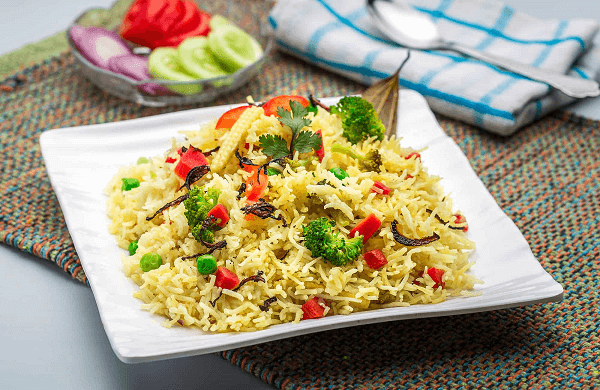
In India, pulao is often made with basmati rice, cooked with cumin, cinnamon, cardamom, and cloves, and mixed with vegetables like peas, carrots, and potatoes, and sometimes with meat like chicken, lamb, or beef. The dish is typically served with raita or curry.
In the Middle East, pulao is often made with saffron-infused rice mixed with lamb, chicken, or beef, along with various vegetables like onions, tomatoes, and carrots.
Overall, pulao is a versatile dish that can be customized to suit individual preferences and dietary requirements, making it a popular choice for many people worldwide.
Origin of Pulao
The origin of Pulao can be traced back to ancient Persia (modern-day Iran), where it was known as "polow". Persian traders and travelers introduced the dish to India and other parts of the world. Over time, it evolved into different regional variations with unique ingredients and cooking methods.
Pulao became a popular dish in India during the Mughal era (16th to 19th centuries) when the Mughal emperors brought Persian cuisine to the Indian subcontinent. The dish was refined and adapted to local tastes, resulting in various regional variations such as Lucknowi Pulao, Hyderabadi Pulao, and Kashmiri Pulao.
Pulao also became popular in other regions of the world, such as the Middle East, Central Asia, and Southeast Asia. There, it underwent regional modification, including unusual ingredients and cooking techniques. For example, in the Middle East, Pulao is known as "pilaf" and is often made with saffron-infused rice mixed with lamb, chicken, or beef, along with various vegetables like onions, tomatoes, and carrots. Overall, Pulao has a rich history and has been enjoyed by people in different parts of the world for centuries.
Ingredients of Pulao
The ingredients of Pulao can vary depending on regional variations and personal preferences. However, some common ingredients that are often used in Pulao include:
- Rice: Often, long-grain rice is used to make pulao, such as Basmati rice, renowned for its fragrant scent and fluffy texture.
- Spices: Pulao is seasoned with various aromatic spices, such as cumin, cardamom, cinnamon, cloves, and bay leaves. These spices add flavor and fragrance to the dish.
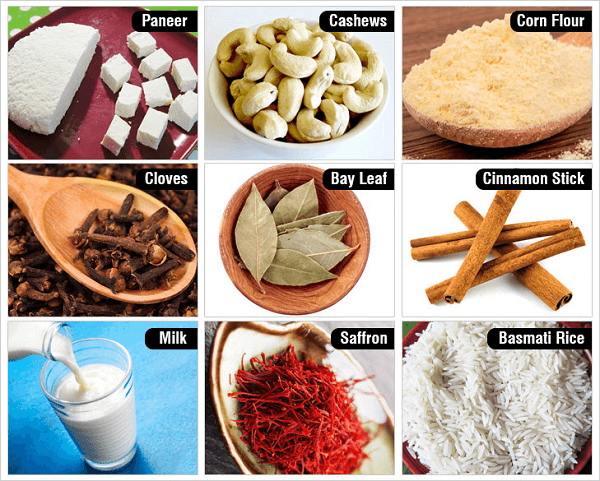
- Vegetables: Peas, carrots, potatoes, onions, tomatoes, and bell peppers are just a few veggies used to make pulao. These vegetables add texture, color, and nutrition to the dish.
- Meat or Protein: Pulao can be made with meat such as chicken, lamb, beef, or fish or with plant-based protein sources such as tofu or chickpeas. The protein adds flavor and nutrition to the dish.
- Oil or Ghee: Pulao is often cooked with oil or ghee (clarified butter), which adds richness and flavor to the dish.
- Nuts and Dried Fruits: Some variations of Pulao include nuts and dried fruits, such as almonds, cashews, raisins, and apricots. These ingredients add texture and sweetness to the dish.
Preparation Style of Pulao
The preparation style of Pulao involves a few basic steps, which can be customized depending on the recipe and personal preferences. Here is an overall overview of how Pulao is prepared:
- Rinse the Rice: Use cold water to rinse the rice to get rid of any extra starch or contaminants. Soak the rice in water for at least 30 to 60 minutes to ensure that it cooks uniformly.
- Fry the Spices: Heat oil or ghee in a pan or pot and add whole spices like cumin, cardamom, cinnamon, cloves, and bay leaves. Fry the spices until they are fragrant and lightly toasted.
- Saute the Vegetables: Add the chopped onions and cook them until transparent. Then add other vegetables like carrots, peas, and potatoes and saute for a few minutes until lightly cooked.
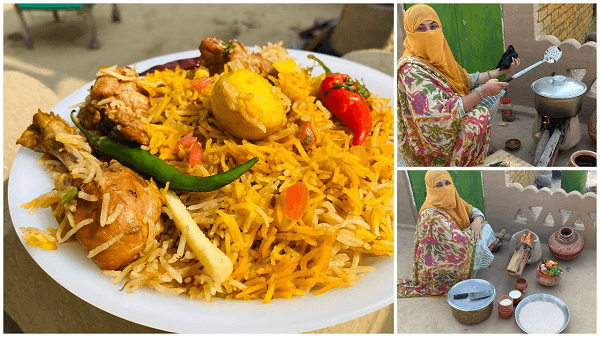
- Add the Rice: Channel the doused rice and add it to the pot with the flavors and vegetables. Mix delicately to cover the rice with the flavors and cook for a moment.
- Add the Liquid: Add hot water or broth to the pot, using a ratio of 1:2 (1 cup of rice to 2 cups of liquid). Add salt to taste.
- Cook the Pulao: Once the liquid has reached a rolling boil, turn the heat down to low and secure the lid. Cook the Pulao for 15-20 minutes, or until the rice is fully cooked and the liquid has been absorbed.
- Fluff and Serve: Once the rice is cooked, turn off the heat and let it sit for a few minutes. Mix the rice with a fork to separate the grains and add additional ingredients like nuts, dried fruits, or fresh herbs.
Varieties of Pulao
Pulao is a versatile dish made with various ingredients, spices, and cooking techniques, resulting in various regional variations and styles. Here are some of the most popular varieties of Pulao:
- Vegetable Pulao: This Pulao is a well-liked vegetarian dish that is made with a variety of vegetables, including peas, carrots, potatoes, and bell peppers.
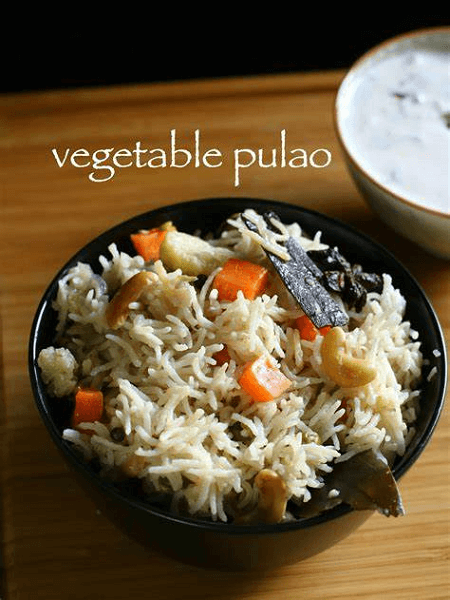
- Chicken Pulao: This famous non-vegetarian pulao is made with chicken parts and frequently flavored with herbs and spices, including cumin, coriander, and cinnamon.
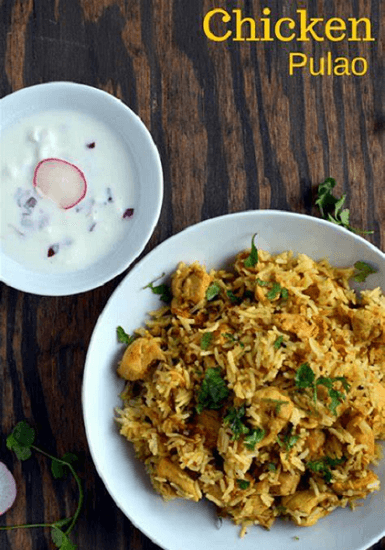
- Mutton Pulao: Made with tender pieces of lamb or goat meat, this is a rich and flavorful option often served during special occasions or festivals.
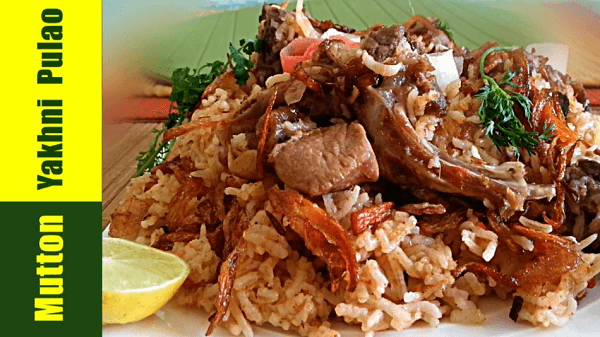
- Fish Pulao: Made with fish fillets or chunks, this coastal specialty is often flavored with coconut milk and tamarind.
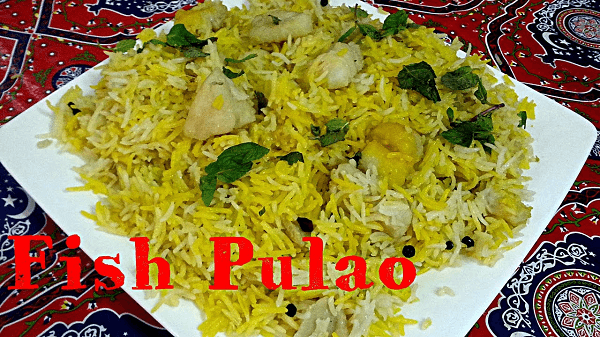
- Egg Pulao: Made with boiled eggs, this is a popular breakfast or lunch option and is often served with a side of raita or yogurt.
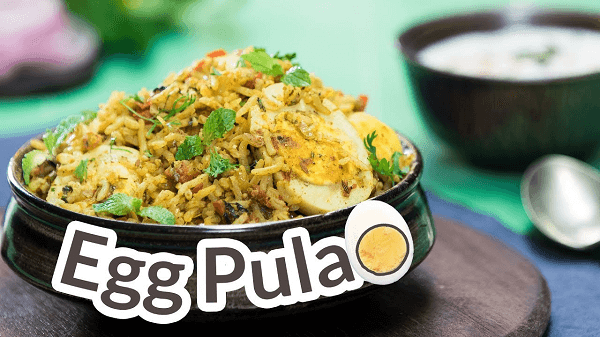
- Hyderabadi Pulao: This is a specialty of the city of Hyderabad in India and is often made with a mix of aromatic spices like cumin, cardamom, and cloves, along with chicken or mutton pieces and caramelized onions.
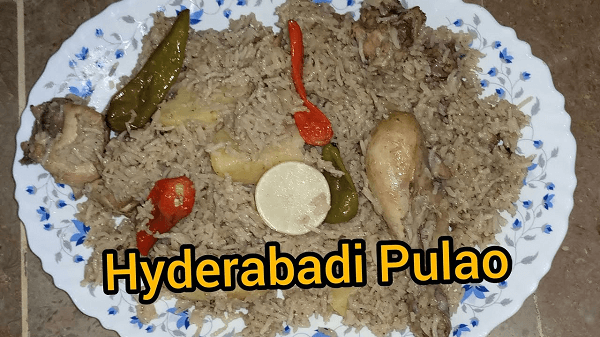
- Kashmiri Pulao: Made with Basmati rice, saffron, dry fruits, and nuts, this Pulao is a specialty of the Kashmiri region and is often served during special occasions or festivals.
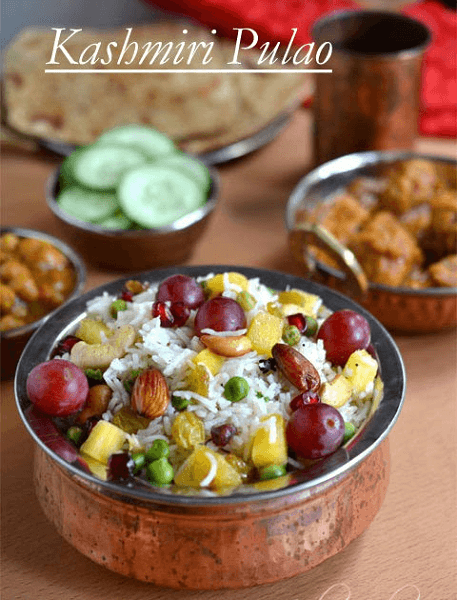
Biryani
Muslims in India's subcontinent first invented the mixed rice meal known as biryani. It is cooked with rice, Indian spices, and often some meat (chicken, cow, goat, lamb, prawn, and fish) but can also be made entirely without meat. Sometimes, it's possible to utilize eggs and potatoes.
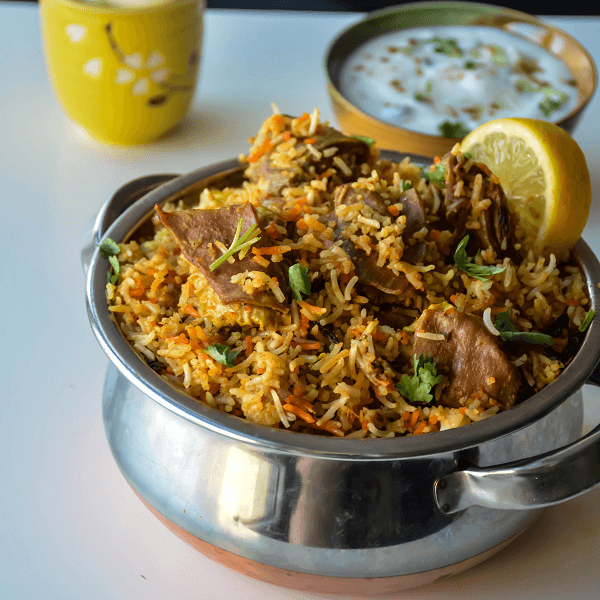
Biryani is one of the most well-liked foods in South Asia and among the diaspora from the region. Several countries of the world, including Iraq, Burma, Thailand, and Malaysia, also produce meals of a similar nature. The most frequently ordered dish on Indian online food ordering and delivery services is biryani, dubbed the nation's favorite dish overall.
Origin of Biryani
Unknown is the dish's exact place of birth. The Muslim-dominated towns of Delhi (Mughlai cuisine), Rampur, Lucknow (Awadhi cuisine), and other teeny-tiny principalities saw the development of many forms of biryani. Many different types of biryani have developed in South India, where rice is a more common staple food. These areas include the Hyderabad Deccan (where some believe the dish originated), Telangana, and the Muslim-populated states of Tamil Nadu (Ambur, Thanjavur, Chettinad, Salem, Dindigal), and Karnataka (Bhatkal).
According to history expert Lizzie Collingham, the state-of-the-art biryani was made in the supreme kitchens of the Mughal Domain (1526-1857) and is a mix of the neighborhood searing rice dishes of India and the Persian pilaf. Indian restaurateur Kris Dhillon acknowledges that the dish started in Persia and was brought to India by the Mughals.
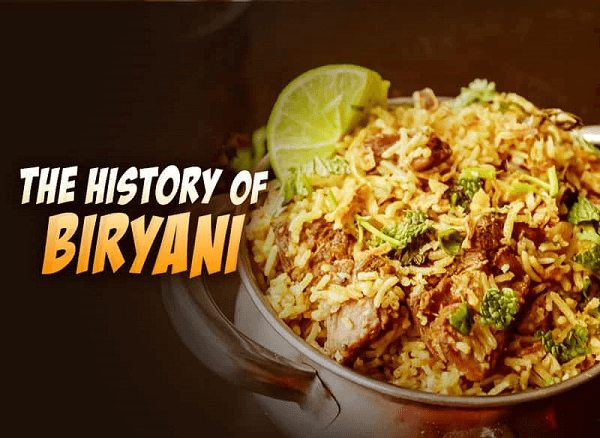
Another theory suggests that the meal was prepared in India before Babur, the first Mughal emperor, conquered the country. The Mughal literature Ain-I-Akbari, written in the fifteenth century, does not distinguish between biryanis and pilaf (or pulao), noting that "biryani" has a long history of use in India. Since there is no evidence of biryani having been in Timur's region around that time, the comparison idea that it arrived in India with his invasion has all the makings of being incorrect.
The author of the book Biryani, Pratibha Karan, claims that biryani has Mughal origins and was inspired by the variety of pilafs that Middle Eastern traders brought to the Indian subcontinent. She speculates that pulao served as a meal for soldiers in ancient India. Military soldiers would prepare a rice meal in one pot with whatever meat was available. As a result of diverse cooking techniques throughout time, the meal eventually evolved into a biryani, with the distinction between "pulao" and "biryani" becoming inconsistent.
As per Vishwanath Shenoy, the proprietor of a biryani eatery network in India, one part of biryani comes from the Mughals, while one more was carried by the Middle Easterner merchants to Malabar in South India.
Although several spurious tales link the creation to Shah Jahan, renowned historian Rana Safvi claims she could only locate a recipe from the later Mughal era, during Bahadur Shah Zafar's reign. She claims that she has not found a recipe; she does not assert that there was no biryani before then. According to some historians who have studied manuscripts, the first mentions of biryani don't come until the 18th century.
Ingredients of Biryani
Different biryanis have different ingredients depending on the geography and the type of meat and veggies used. The main component of biryani is meat, which can be either fish, prawns, chicken, goat, cow, or lamb. The preparation of biryani occasionally includes the inclusion of vegetables, as is typical of meals from the Indian subcontinent. Depending on the time of year and availability, maize may be utilized. Cashews, raisin, and fruits like apples and pineapples are sweeter, richer ingredients frequently used in navratan biryani.
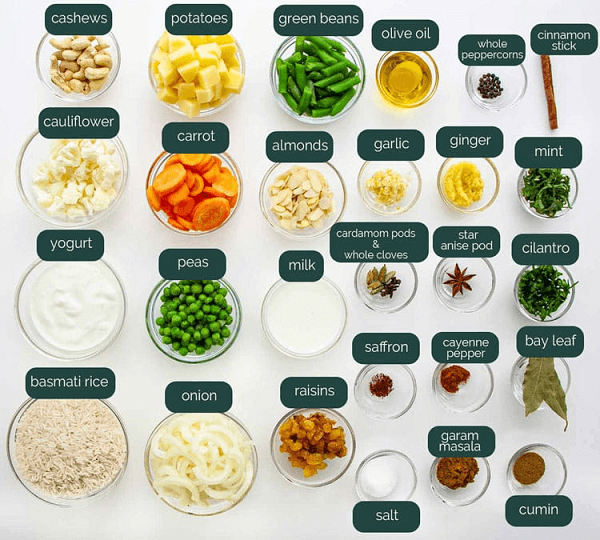
Fennel seeds, ghee (clarified butter), nutmeg, mace, pepper, cloves, cardamom, cinnamon, bay leaves, coriander, mint, ginger, onions, tomatoes, green chilies, and garlic are a few potential components used in biryani. The most expensive kinds contain saffron.
The fundamental fixing that normally goes with the flavors is chicken or goat meat; unique assortments could utilize hamburgers or fish, all things being equal. The meal may be served with salad, korma, curry, a sour dish of aubergine (brinjal), dahi chutney or raita, bubbling egg, and korma.
Preparation Style of Biryani: Pakki Versus Kacchi Biryani
- Before being layered in a cooking pot, the rice, marinated meat, and veggies do independent cooking in a Pakki biryani. Various layers of rice might be treated with various flavors, e.g., with disintegrated saffron or turmeric, to give the rice various varieties and flavors
- After that, the food is heated to complete the cooking process and allow the flavors to meld. The components might, however, be fully cooked before being effectively layered together before serving.
- In a kacchi biryani, layers of unseasoned meat are replaced with wet, pre-soaked rice prepared with various tastes, as described above. The layers are baked or cooked with medium-to-low direct heat (commonly for 60 minutes). Cooking is done by steaming from the ingredients' moisture; the top of the cooking pot is fastened (often with a piece of wheat batter) to prevent steam from escaping.
- A marinade made of yogurt adds flavor and moisture to the bottom of the cooking pot. As potatoes often have a high moisture content and are less likely to burn themselves accidentally, they usually add the foundation layer (a technique also used in Persian cuisine). Indeed, pakki biryani is far less demanding and time-consuming than kacchi biryani for the following reasons:
- The cooking times for the various fixings-meat, rice, and potatoes-vary. Delicate pieces of meat or chicken might be fully cooked well before the rice is done. Several kacchi recipes use parboiled (semi-cooked) rice instead of raw rice to prevent this.
- The risk of burning the food layer in contact with the vessel bottom when using direct heat exists if this method is used for cooking the food. This risk is reduced by continuously baking at a moderate temperature or cooking very slowly over low direct heat. Nevertheless, using this method significantly extends the cooking time.
- It requires knowledge of the raw ingredients used, the heat needed to cook those raw ingredients, and how the environment might impact the cooking process to cook a meal "blind," with the cooking vessel shut so that one cannot observe the cooking progress. Hence making kacchi biryani requires a seasoned hand.
Varieties of Biryani
There are several varieties of biryani, and their names are frequently derived from their places of origin. For instance, Hyderabadi biryani originated in the city of Hyderabad in South India, whereas Sindhi biryani originated in the Sindh region of Pakistan.
For instance, the name of the restaurant serving it has been used for Haji Biriyani, Haji Nanna Biriyani in Old Dhaka, Fakhruddin Biriyani in Dhaka, Students Biriyani in Karachi, Lucky Biriyani in Bandra, Mumbai, and Baghdadi Biriyani in Colaba, Mumbai. The originating Muslim communities' distinctive dishes, biryanis, are frequently unique to those communities.
- Ambur/Vaniyambadi Biryani: The neighboring Tamil Nadu cities of Ambur and Vaniyambadi, which have a substantial Muslim population, produce the cuisine known as Ambur/Vaniyambadi biryani. The Nawabs of Arcot, who formerly dominated the region, introduced it. Often, jeera samba rice is used to make it.
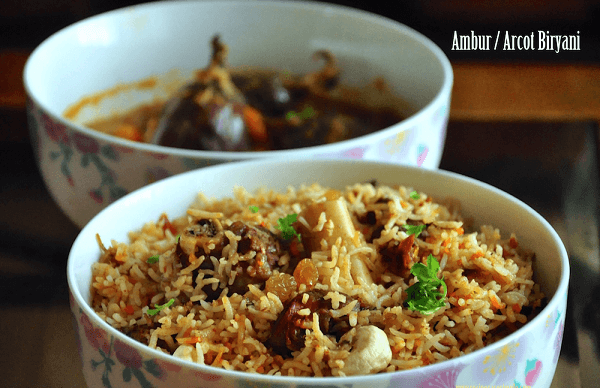
Other names used include Haji Biriyani, Haji Nanna Biriyani in Old Dhaka, Fakhruddin Biriyani in Dhaka, Students Biriyani in Karachi, Lucky Biriyani in Bandra, Mumbai, and Baghdadi Biriyani in Colaba, Mumbai. The originating Muslim cultures' distinctive meals, biryanis, are frequently unique to those groups.
- Beef Biryani: As the name suggests, the meat in beef biryani is beef. In Hyderabad, it is well-known as Kalyani biryani and is made with either buffalo or cow meat. At some time in the eighteenth century, the Kalyani Nawabs of Bidar visited Hyderabad, and this feast was then started. The Kalyani biryani has little beef shapes, standard flavors, onions, and numerous tomatoes. It has an unmistakable tomato, jeera, and dhania flavor. In Kerala, beef biryani is notable. The Bhatkali biryani is a unique variation where the principal fixing is onion.
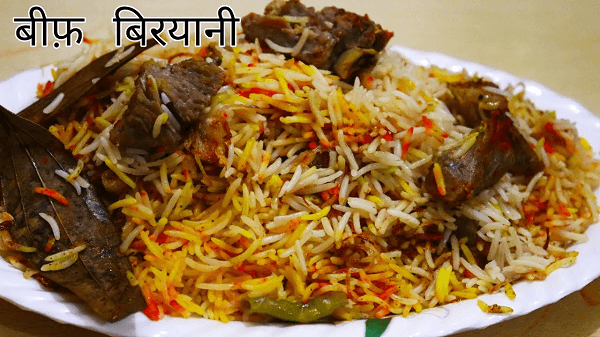
- Bhatkali/Navayathi Biryani: This dish is a mainstay of Navayath cuisine and a specialty of Bhatkal, a seaside town in Karnataka. Its roots may be linked to the Persian traders who also left behind various kababs and Indian flatbread, and biryani. In Bhatkali biryani, the onion and green chilies serve as the base, on top of which the meat is cooked in a fragrant rice combination. It has a distinct flavor is spicy and strong, and the rice is primarily white with faint orange streaks.
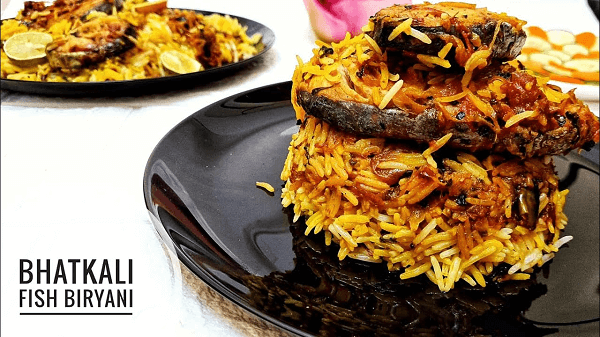
This biryani varies from those in Thalassery while tasting identical to them because of the lingering aromas of mashed onions flavored with garlic. Bhatkal biryani has a distinct flavor from a few chilies, spices, and a scattering of curry leaves. Oil is not utilized.
- Delhi Biryani: The Delhi form of biryani fostered an exceptional neighborhood flavor as the Mughal rulers moved their political funding toward the North Indian city of Delhi. Until the 1950s, the vast majority cooked biryani in their home and seldom ate at restaurants beyond their homes. Consequently, cafés essentially took care of explorers and shippers.
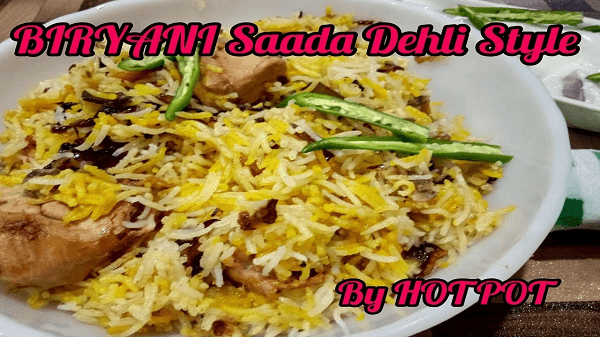
Every region of Delhi has its distinct kind of biryani, frequently based on its original function, giving rise to dishes like Nizamuddin biryani and Shahjahanabad biryani, etc. While Nizamuddin biryani was initially intended to be cooked in mass for giving at the Nizamuddin Dargah shrine and afterward to be distributed to worshippers, it often featured little pricey meat and spices. The Babu Shahi Bawarchi shops near the National Sports Club in Delhi gave the non-dum biryani known by its vernacular name, "Babu Shahi biryani," which extensively uses green chilies. A different kind of Delhi biryani is known as achaari biryani and uses achaar (pickles).
- Hyderabadi Biryani: The most well-known biryani in India is Hyderabadi, and some people believe that Hyderabad and biryani go hand in hand. Hyderabadi biryani, the emblematic dish of Hyderabadi cuisine, is ascribed to Asaf Jah I, who was initially appointed as the administrator of Deccan by the Mughal Emperor Aurangzeb. Basmati rice, herbs, and spices are used in its preparation. A common substitution for goat meat is chicken. There are other varieties of Hyderabadi biryani, including kachay gosht ki biryani and dum biryani, including goat meat marinated and cooked alongside the rice.
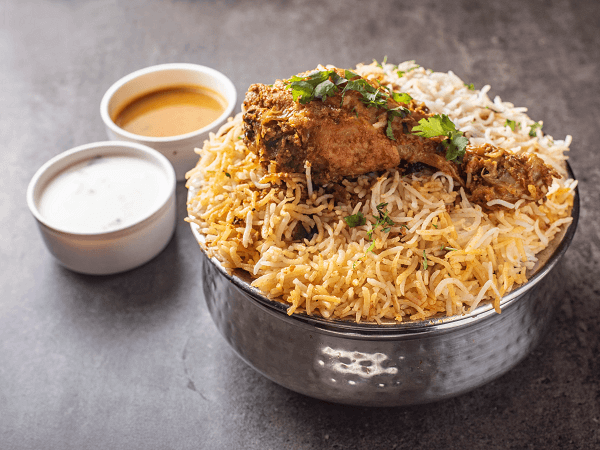
Key Difference Between Pulao and Biryani
| Feature |
Pulao |
Biryani |
| Cooking Method |
Rice is cooked with the broth/stock and spices together |
Rice and meat/vegetables are cooked separately and then layered together with spices and garnishes |
| Meat/vegetables |
Often includes only one main ingredient, such as vegetables, chicken, or lamb |
It can include multiple types of meat, vegetables, and sometimes even seafood |
| Spices |
Typically mild and subtle, with just a few key spices like cumin and coriander |
A complex blend of spices, including cinnamon, cardamom, cloves, and more |
| Color |
Rice is usually a uniform color |
Rice is often layered with a mix of colorful spices and ingredients |
| Garnish |
Minimal or no garnish |
Often topped with fried onions, raisins, and nuts |
| Serving Style |
Served as a main dish or accompaniment to a curry or other main dish |
Served as a standalone main dish |
| Regional Variations |
Found in many regions, including India, Pakistan, and Bangladesh |
Often associated with the Hyderabad region of India, but also popular in other parts of South Asia |
|




 For Videos Join Our Youtube Channel: Join Now
For Videos Join Our Youtube Channel: Join Now
























